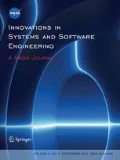Abstract
In this paper, we have proposed a methodology towards improved business process model redesign based on QoS. We have extended an existing framework that generates an exhaustive space of process models from a set of capability library. The solution space is pruned based on goal and constraints considered thereafter. An algebraic framework is deployed that permits integrated multi-dimensional assessments of QoS factors for choosing path from the reduced space towards derivation of an optimal business process model by comparing the QoS values on both quantitative and qualitative scales. The proposed methodology ensures that while deriving a solution, no possible superior business process model is left out. Further, the designs that do not satisfy the given constraints are eliminated. Eventually, the extended and improved framework provides a comprehensive, both syntactically and semantically correct, consistent and improved business process that adheres to the target business goals and constraints specific to a business house. A use case is used to describe our methodology.



Similar content being viewed by others
References
Agrahari A, Mithal S, Bhat J (2010) Pattern-based process optimizer. In: U.S. Patent No. 20,100,114,632. Washington, DC: U.S. Patent and Trademark Office
Alotaibi Y, Liu F (2013) Business process modelling towards derive and implement it goals. In: Industrial electronics and applications (ICIEA), IEEE, pp 1739–1744
Bistarelli S, Montanari U, Rossi F (1997) Semiring-based constraint satisfaction and optimization. J ACM (JACM) 44(2):201–236
Constantinescu Irina FP, Cristea V (2011) Performance analysis of workflows for service oriented computing. In: International conference on emerging intelligent data and web technologies (EIDWT), IEEE, pp 186–191
Deb D, Chaki N (2016) A framework for goal compliance of business process model. In: Proceedings of the 4th international conference on advanced computing, networking, and informatics, Springer
Deb D, Chaki N, Aditya G (2015) Business process generation by leveraging complete search over a space of activities and process goals. In: Proceedings of the 5th International conference on cloud computing and services science (CLOSER 2015), ScitePress, pp 233–240
Kiepuszewski B, ter Hofstede AHM, Bussler CJ (2000) On structured workflow modelling. Lect Notes Comput Sci 1789:431–445
Kumar M, Bhat J (2011) Process improvement by simplification of policy, and procedure and alignment of organizational structure. AMCIS 2011:346–353
Lan CW, Chen RC, Su AY, Huang AF, Yang SJ, Chung JY (2009) A multiple objectives optimization approach for qos-based web services compositions. In: IEEE international conference on e-business engineering, IEEE, pp 121–128
Lodhi A, Köppen V, Wind S, Saake G, Turowski K (2014) Business process modeling language for performance evaluation. In: 2014 47th Hawaii international conference on system sciences, IEEE, pp 3768–3777
Mansar SL, Reijers HA, Ounnar F (2009) Development of a decision-making strategy to improve the efficiency of BPR. Expert Syst Appl 36(2):3248–3262
Papazoglou MP (2008) The challenges of service evolution. In: International conference on advanced information systems engineering, Springer, pp 1–15
Phalp K, Shepperd M (2000) Quantitative analysis of static models of processes. J Syst Softw 52(2):105–112
Reijers HA, Hee KM (2002) Product-based design of business processes applied within the financial services. J Res Pract Inf Technol 34(2):110–122
Reijers HA, Mansar SL (2005) Best practices in business process redesign: an overview and qualitative evaluation of successful redesign heuristics. Omega 33(4):283–306
Van der Aalst WM, Hirnschall A, Verbeek H (2002) An alternative way to analyze workflow graphs. In: International conference on advanced information systems engineering, Springer, pp 535–552
Wu Z, Shaowen Y, Gang H, Xue G (2011) Rules oriented business process modeling. In: IEEE international conference on internet technology and applications (ITAP), pp 1–4
Xue Sida BW, Chen J (2013) Lightepc: A formal approach for modeling personalized lightweight event-driven business process. In: IEEE international conference on services computing (SCC 2013), IEEE, pp 1–8
Yu T, Lin KJ (2005) A broker-based framework for qos-aware web service composition. In: 2005 IEEE international conference on e-technology, e-commerce and e-service, IEEE, pp 22–29
Zakarian A (2001) Analysis of process models: a fuzzy logic approach. Int J Adv Manuf Technol 17(6):444–452
Zhang Y, Perry DE (2014) A goal-directed modeling technique towards business process. In: IEEE 8th international symposium on service oriented system engineering (SOSE), IEEE, pp 110–121
Zhou Y, Chen Y (2003) The methodology for business process optimized design. In: The 29th annual conference of the IEEE industrial electronics society, 2003. IECON’03, vol. 2, IEEE, pp 1819–1824
Author information
Authors and Affiliations
Corresponding author
Rights and permissions
About this article
Cite this article
Deb, D., Ghose, A. & Chaki, N. A framework for business process modeling by QoS-based pruning. Innovations Syst Softw Eng 13, 271–278 (2017). https://doi.org/10.1007/s11334-017-0293-2
Received:
Accepted:
Published:
Issue Date:
DOI: https://doi.org/10.1007/s11334-017-0293-2




